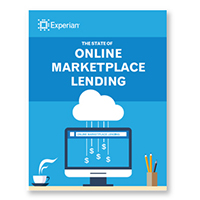
Simply put, online marketplace lending is here to stay. Virtually unheard of just 10 years ago, Web-based companies that offer funding options beyond traditional bank loans have grown considerably. Small businesses — drawn by the easy application process and flexible repayment terms, have become increasingly comfortable working with online lenders, which offer rapid access to capital, a wide array of niche products, and a low-friction customer experience.
The lack of regulation and higher-than-market interest rates that often accompany these “alternative” loans have not deterred borrowers from trying this new source of business financing. Despite their growth, however, online lenders still make up only a small segment of the overall small-business loan market.
While that paints a clear picture of the current online marketplace lending environment, what does the future hold? How is the industry, still in its infancy, likely to change as it responds to pressures from competitors, borrowers and regulators?
Here are some trends we can expect to see over the next several years:
Growth — As online lending becomes more mainstream, look for the industry to expand exponentially. In 2014, online lenders combined to issue loans totaling about $12 billion in the United States. In a recent report, Morgan Stanley said it expects the U.S. number to grow to $122 billion by 2020 and the global number to surpass $280 billion in the same time period.

“Online marketplace lenders are still very small players relative to the overall market, but they’re growing fast. They could be very disruptive or an entirely new [source] of capital for both small businesses and consumers that aren’t necessarily serviced by larger banks.”
James Francis
Executive Vice President, Consumer Lending Group
MUFG Union Bank N.A
Participation — Exponential growth likely will be fueled by the growing acceptance of online lending by small businesses, especially those run by millennials comfortable with virtual transactions. As the customer base grows, look for competition to increase as both new and established lenders fight for the attention of this attractive market segment.

“Small-business owners in general are increasingly turning to online options to seek capital. According to a recent study by the Fed, 20 percent of small-business owners sought a business loan online during the first half of 2014. Small businesses are using new technologies to manage their customers, process payments, handle point-of-sale — it makes sense they’d turn online for capital as well.”
James Hobson
Chief Operating Officer
OnDeck
Innovation — New, even more, efficient ways for borrowers to secure business loans — not to mention the nature of the financial products themselves — will continue to appear as competition drives innovation. Look for lenders to develop:
- Faster, more user-friendly interfaces along with algorithms that further accelerate the review and approval process
- Frictionless access
- Improved customer engagement and experience
- Platform and product innovation

“Certainly there are more players in the space today, which is great because it pushes not only us but the category as a whole to generate more awareness, more credibility and better platforms to help small businesses. The category as a whole has been built on this idea of making things a little bit more simple and easy. We’re always asking, ‘How can we provide our offerings in a frictionless way and time-sensitive manner?”
Jason Rockman
Vice President, Brand Marketing
CAN Capital

“There are a lot of lenders offering similar products to the same customers. There will be more competition to offer more products, which is better for borrowers.”
Meredith Wood
Editor-in-Chief
Fundera
Consolidation — Industries often go through a period of hyper expansion followed by a period of consolidation as larger, better-financed players acquire smaller competitors and underperformers go out of business. One hundred years ago, more than 100 companies were making automobiles in the United States alone. Today, there are fewer than a half dozen. Twenty-five years ago, scores of companies were making personal computers. Today, a handful of brands dominate 90 percent of the market. We can expect the online marketplace lending sector to experience similar consolidation.
Spillover — As online lending becomes increasingly mainstream, look for traditional lenders — particularly commercial banks — to enter the fray. Some forward-looking banks already are working directly with online marketplace lenders, referring customers based on their needs and qualifications or re-creating the frictionless look and feel of online lenders. Look for the dramatic differences between “traditional” and “alternative” lenders to blur in the coming years.

“There are several key reasons why banks would want to partner with online lenders. The first is to drive customer retention. A bank says yes to small-business borrowers roughly 20 percent of the time based on their lending criteria. What happens to the other 80 percent? Banks don’t want to lose those customers. Partnering with marketplace lenders is one way to retain those customers and create a good user experience. “Customer loyalty is another driver. Access to capital does more to build loyalty than any other product or service. Finally, the biggest motivator is access to new technology and data, especially for institutions forward-thinking enough to recognize that there are opportunities for them to monetize their existing data as well as learn from the data analysis and data science that some of the more sophisticated marketplace players are executing.”
Glenn Goldman
CEO, Credibly
Regulation — Regulation is on the horizon for the online lending industry. While the absence of regulation has facilitated rapid growth and innovation, this lack of oversight also has led to an environment in which some borrowers have complained of unfair lending practices and a lack of transparency.
Most leading online lenders believe some kind of regulation is good for the industry. A set of rules and standards defines the playing field and provides the confidence and consistency the industry needs to grow sustainably.
“Some government oversight is going to happen. It’s just a matter of time,” said Levi King, Founder and CEO of Nav (formerly Creditera), which was founded in 2012. “Small businesses are not sophisticated. There’s a lot of predatory lending extended to small-business owners, who are, as a rule, not sophisticated enough to know what’s happening.”
“We believe it’s important to foster greater transparency in business lending marketing,” said Rebecca Shapiro, Director, Brand & Strategy, Funding Circle. Along with Fundera, Lending Club, Opportunity Fund and Accion, Funding Circle recently helped craft the Online Borrowers Bill of Rights, which attempts to establish ethical standards the industry can use to police itself. “We don’t assume the bill can replace government regulations. We do believe that, by encouraging responsible regulations, we’ll have a model for what the government should do,” said Shapiro.
The Future Is Bright
Customer engagement, access, frictionless applications, and a wide range of product choices are at the heart of the online marketplace lending industry. The mainstream banking industry is starting to take note, looking externally at possibilities for collaboration and internally at ways of updating systems and processes to improve the customer experience. Ethical standards and regulations will increase transparency, accountability, and consistency. If these trends continue, both the small-business owner and the economy will reap the benefits.
The State of Marketplace Lending

In 2008, a short two years after the first online marketplace lenders opened for business, the Great Recession began to wreak havoc on worldwide financial markets. Small businesses struggled to survive, banks failed and access to capital was limited. More online lenders saw an opportunity and opend for business. These technology-driven newcomers hired an army of data scientists, coders and digital marketers. In the fall of 2015 the innovation, industry disruption and regulatory uncertainty that characterize this dynamic sector led Experian to produce a series of articles focusing on different aspects of online marketplace lending. This report contains those articles.
Related articles
Just how alternative are today’s online marketplace lenders?
How online marketplace lenders are changing the rules of small-business finance
Self-Regulatory Program for Nonbank Small Business Lenders
Top regulatory priorities for commercial lenders
Playing to Your Strength – Opportunities for Regional Banks to Build Better Lending Portfolios
Game Changer – How Marketplace Platforms Are Bringing Financial Institutions Back to Small-Business Lending
Marketplace Matchmakers – How Loan Aggregators Bring Borrowers and Lenders Together
New Frontiers – What’s Next For Marketplace Lending?
